© 2020 (Do not copy or redistribute this document)
Reign of Queen Victoria
On 20 June 1837, King William IV died and Victoria, age 18, became Queen of the United Kingdom.

The following Tables (repeated from previous section) give the results of the 1835 Census for Bareneed and the surrounding towns. At that time Bareneed (see note) had a population of 220 male householders, 212 females in these households, 42 male servants and 16 female servants occuping 71 dwelling houses. This gives an average of just over 6 family members per household plus an average of just under one servant per household.
Note: Bareneed stats include Sandy Cove, a small village, on the western end of Port de Grave.

In June 1839 Joseph Beete Jukes a geologist working for the Newfoundland Government visited Port de Grave and Bay Roberts and wrote the following description of the area:

There were Newfoundland Government Censuses taken during this period but only summary reports survive so there are no comprensive list of residents; however, we can get partial list of residents from list of subscribers to the Newfoundland Church Society (see 1847 & 1857 below) and from directories of residents published by various private companies (e.g. Lovell’s Directory for 1871 and McAlpine’s 1898 Directory).
The Newfoundland Church Society was founded in 1841 to raise money within Newfoundland to support churches and schools in the colony. The money raised by the Society was intended to reduce and eventually eliminate support provide by the UK based Society for the Propagation of the Gospel, on which the Church in this Colony has hitherto depended for support, is no longer able to extend and increase its bounty to us as our increasing wants demand. The rules of the Society included the following outlined in the Report of 1847.

The Society for the Propagation of the Gospel Mission for Port de Grave, which included St. Mark’s Church in Bareneed, was one of 22 missions that contributed funds in 1846 (reported in 1847). The Newfoundland Church Society report for 1847 list individuals that contributed (see below). It likely did not include many, if any, Roman Catholics and Methodist (the former represented aproximately 15% of the population at that time and the latter 4%). It would also exclude anyone who did not contribute for financial or other reasons.

Ten years later the same Church Society Report for 1857 combined all of Bareneed into one list with 94 subscribers. By this time Roman Catholics represented approximately 10% of the population and Methodist 5%.

The Newfoundland Census for 1857 gives the population of Bareneed as 432 with 67 inhabited houses and the population of the Dock as 151 with 23 inhabited houses (with 25 families). With 583 individuals occupying 90 houses this gives approximately 6.5 individuals per house. With 92 families a number of which are Roman Catholics and Methodist and 94 suscribers it suggest that there were frequently multible subscribers in a family (perhaps single adult sons living at home).
The Newfoundland Census of 1869 gives the population of Bareneed as 460 and that of the Dock as 125 (585 Total). The number of inhabited houses was 71 for Bareneed and 21 for the Dock (92 total). This gives approximately 6.4 individuals per house.
Lovell’s Directory for 1871 includes a relatively complete list of adult male residents for Bareneed (86) but did not include the Dock.
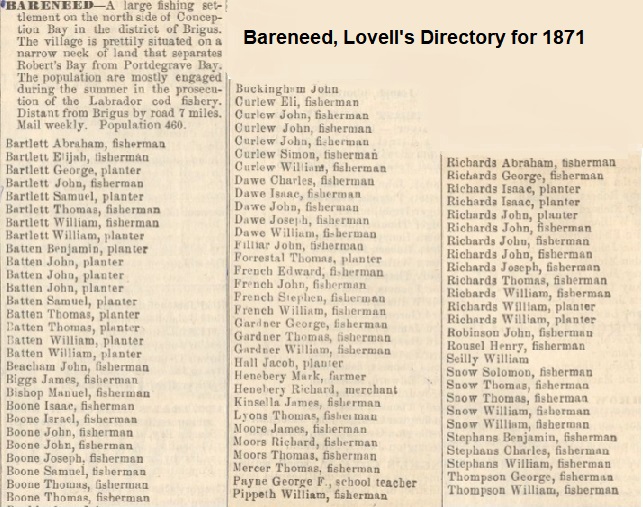
The Newfoundland Census of 1891 Table I (see below) gives the population of Bareneed as 447 and the Dock as 154 for a total of 601. Table II gives the number of inhabited houses as 87 for Bareneed and 31 for the Dock (118 Total).
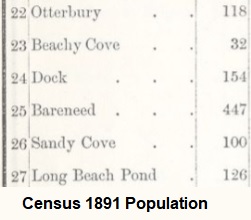
McAlpine’s 1898 Directory for Bareneed and the Dock list 174 individuals (mainly adult males).
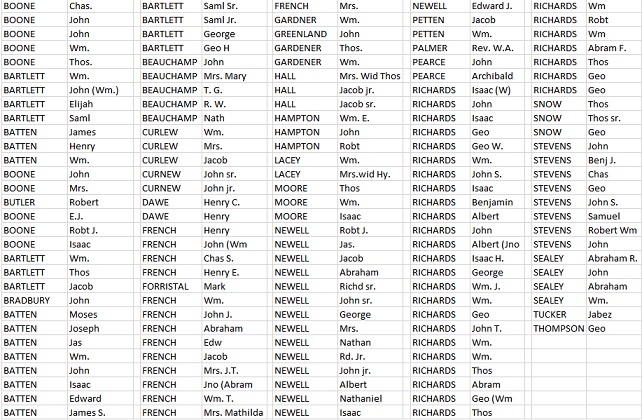
During this period the economy of Bareneed was based on the seal fishery (AKA Seal Hunt) and the Labrador cod fishery supplemented by shipbuilding and agriculture.
Seal Fishery

By the start of this period (1837) the Seal fishery was already an established industry in Newfoundland.

Chafe’s sealing book, 1923, p. 39
By 1837 the Seal fishery was already nearing its peak production (see Graph below). However, in terms of employment and level of effort (number of ships) the industry continued to expand for another quarter century.
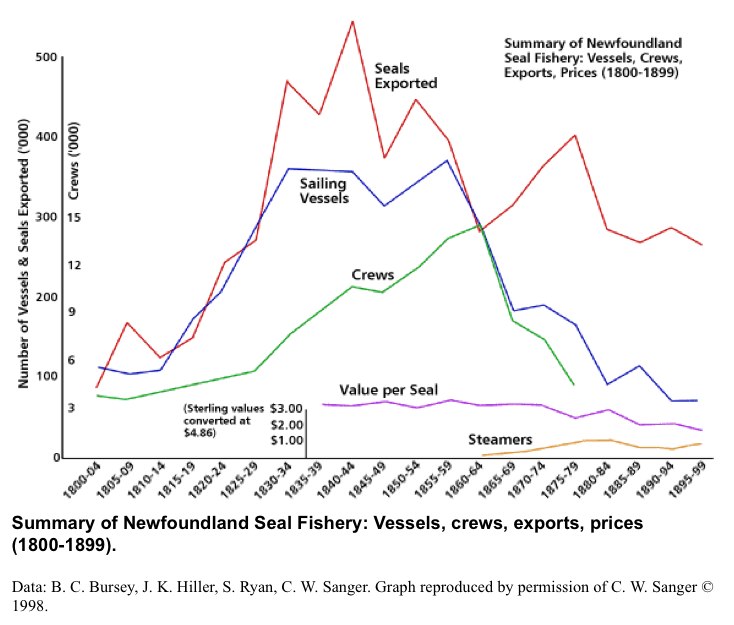

In 1857 there were four hundred vessels of from seventy to two hundred tons engaged in the seal fishery, their united crews totalling thirteen thousand men (Chafe’s Sealing Book, 1923) . In the 1857 Census, Bareneed had 6 large vessels involved in the fishery with a total tonnage of 652 Tons. The census also recorded a catch of 7400 seals for Bareneed, more than the 7020 at Port de Grave but nothing compared to Brigus with 38,702. See Notes below:
- These numbers differ significantly from those given in Decks Awash, 1986, Vol 15 #2 p. 12) .
- In 1857 Brigus was becoming the base for the larger ships involved in the seal fishery.
- It is not clear if the Bareneed seal catch in the Census records seals landed by boats from Barenned or seals actually landed at Bareneed.
The spring of 1857 was a good year for seals and the sealer Rake of Bareneed (see below) had a catch of 3200 seals (Chafe’s sealing book, 1923, p.41).
The Rake (J. Batten) is the only sealing vessel I can clearly link to Bareneed.
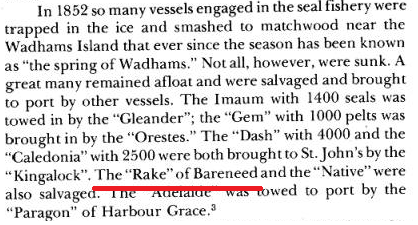
In 1847 the Rake under Batten (116 Tons and 35 men) like many other ships from Conception Bay had cleared for the seal fishery from the Brigus. In 1852 the Rake was listed as sailing from Port de Grave (see below) but this list likely included all ships from the Port de Grave Peninsula (see below).

The Weekly Herald And Conception-Bay General Advertiser, 1852-03-17, vol. 10, no. 489
Several other ships on this list were very likely from Bareneed.
- The Isaac and Elizabeth (105 Tons) was built in Bareneed in 1835 and her master John Richards was a resident of Bareneed.
- The Charles (84 Tons) may have been a successor to the Charles and Edward (48 Tons) built in Bareneed in 1819 by John Richards and lost c 1827.
- A schooner Lady Ann (115 Tons) was built at Barenned in 1831 and was registered by William and John Richards of Bareneed. In 1852 she was commanded by “Boone” a common Bareneed name but not found in Port de Grave.
- Re the vessel Sealer, commanded by B. Batten. In 1864 Benjamin Batten was a schooner owner in Bareneed (see Hutchinson Directory).
- The Sea , Batten might also be a Bareneed vessel. In1844 Samuel Batten was captain of the sealer Sea and there was a Samuel Batten, Planter and captain, who lived in Bareneed at this time.
- A schooner United Brothers (49 Tons) was built in Bareneed in 1834 and in 1814 a Delaney had inherited land in Bareneed (in latter years this family found in Otterbury)
Overall, it is possible that half of the sealing vessels listed under Port de Grave in 1852 were operated by families from Bareneed. In 1853 the Batten and Richards families from Bareneed are still involved in the seal fishery however, some of the vessels had changed (see below).

The Weekly Herald And Conception-Bay General Advertiser, 1853-03-23, vol. 11, no. 542
The 115 Ton Volante (see above) was a new Brigantine built in Bareneed in 1852 by John Richards of that town. John Richards died in 1853 and in his Will he left the Volante to his wife and son Isaac: I also give and bequeath to my dear wife one third part of my vessel named the Volant (being the only one now in my possession) the remaining two thirds of the said vessel I give to my son Isaac. His Will suggest that he owned more vessels in the past.
In 1854 sealing ships from Port de Grave were included with ships from Brigus, Bay Roberts, Cupids and Harbour Main under Brigus.
However, by the end of the 1860s the sealing industry was declining in terms of its economic impact on the Newfoundland economy and structural changes, a shift from local schooners to large steam ships owned by merchants operating out of St. John’s, Harbour Grace and Brigus were reducing its importance in communities like Bareneed. The introduction of wooden steamers in 1862 revolutionized this business, and since that date 20 to 25 steamers [none based in Bareneed] have constituted the annual fleet, with few exceptions (Chafe’s Sealing Book, 1923).
The last ship linked to Bareneed that played a significant role in the Seal fishery was the Estelle, owned by Richard Hennebury of Bareneed. The Brig Estelle (176 Tons) was built in Prince Edward Island in 1860 and in 1865 and 1868 she was registered (Mercantile Navy List and Maritime Directory) to Richard “Hemeberry” [Hennebury] of Bareneed. The Estelle was on a list of vessels fitted out for the Seal Fishery at Harbor Grace in 1861:
“Estelle, Hennebury 176 tons 60 men”
http://collections.mun.ca/PDFs/cns_period/ShortisPapersVol03Part01.pdf
The Estelle was lost in a storm off Labrador in October 1867. The next section of this report, Labrador Cod Fishery, provides more information on Richard Hennebury and the Estelle.
Labrador Cod Fishery
The decline in the schooner based Seal Fishery in the 1860s did not have a major impact on the fishermen living in Bareneed and the Dock since they continued to go to the seal hunt each spring on large steamers based in Brigus, Harbour Grace or St. John’s. However, the local schooner owners were faced with a loss of a significant portion of their income. These schooner owners now had to support their vessels solely based on the Labrador fishery. Perhaps not coincidentally this period corresponded with an increase in the Labrador cod fishery.

Hutchinson 1864-65 Directory list the following schooner owners at Bareneed:

Three of these schooner owners, Benjamin Batten, Thomas Batten and Thomas Richards, represent families that had been established in Bareneed since the 18th century and were some of the first families to own sealing schooners. The one that stands out is Richard Hennebury.
A good description of Richard Hennebury comes from the March 29, 1926 obituary for his relative a Mrs. Moore wife of Mr. Thos. Moore, formerly merchant-planter of Bay de Verde, who died at Cambridge, Mass.
On the maternal side, the deceased was descended from the enterprising planter, Capt. Richard Hennebury, who conducted a very large fishing business at Indian Tickle, Labrador, for many years, and who was one of the most successful seal-killers Newfoundland ever produced. For years he commanded the Thrasher out of McBrides’s, St. John’s and subsequently was owner and master of the splendid brigs Estelle and Anastatia. He conducted a larger mercantile business, in the early days, at Bareneed, and afterwards at Bay Roberts, where he was owner of the brigantine Brighton, also the Fond Mother, Alice H. and several other vessels.
The Hennebury family of Bareneed reportedly arrived from County Cork, Ireland in the early 19th century.

There are references to Haneberry in the Harbour Grace, Catholic Church records for 1819 (James) and 1821 (Mark). Richard Hennebury of Bareneed was Roman Catholic. There is no reference to Hennebury in the 1817 census of Port de Grave region but in 1830 a “Marks Henebery” petitioned for a grant of land at Northern Gut (west of Bareneed). Lovell’s Newfoundland Directory of 1871 lists a Mark (farmer) and Richard (merchant) Henebery at Bareneed. Richard Hennebury’s Will was probated on May 26, 1876; at that time he had moved from Bareneed to Bay Roberts. In his Will he left his Indian Tickle property in Labrador to his son Mark. At least three families at Bareneed (Hennbury, Newell and Richards) had fishing rooms in Indian Tickle.
Indian Tickle lies between Musgrave Land on the west, and Indian Island, on the east, and was formerly a very important settlement. In early days it had a large “room,” owned and operated by Warren, of London, England. When Warren retired from business on the coast, the “room” passed into the hands of Captain Hennebury, of Port-de-Grave, who “made piles of money there.” (WHERE THE FISHERS GO, 1909)
For more information on the Hennebury family and Indian Tickle see the Labrador Connections page under the Newell family section of this Web Site. During the 1860s Richard Hennebury was the largest ship owner in Bareneed. The following is a list of some of his ships and the year they were built:
- Young Harp Schooner 1836 97 Tons
- Thrasher Brig 1850 189 Tons
- Curlew Schooner 1857 168 Tons
- Estelle Brig 1860 176 Tons
- Rapid Schooner 1866 85 Tons
- Prosperity Schooner
- Brighton Brig 1867
- Anastatia Brig 1868 177 Tons
The schooner Young Harp (80 Tons) was built at Bareneed in 1836 by Richard and was likely his first ship. This vessel may have been built at Northern Gut since “Marks Henebery” applied for a land grant in this area in 1830. During this period Northern Gut was considered part of Bareneed. His involvement with the Thrasher is unclear since the Obit presented earlier suggest he commanded the Thrasher out of McBrides’s, St. John’s but it is likely that he was also part owner. The following newspaper clipping from 1860 links her directly to him as master and supplier.

The brig Estelle was registered to Richard Hemeberry of Bareneed in 1865 and 1868 ( Mercantile Navy List). In October 1867 the Estelle sank at Indian Tickle when a terrible storm with heavy fall of snow swept the coast Labrador and reports indicate that most of the crew was lost. Some sources indicate that Richard died in this storm but his Will shows that these reports are incorrect. The Prosperity, Brighton and Anastatia were all mentioned in his Will of 1876 and by this time he was living in Bay Roberts.
Richard Hennebury was still living in Bareneed in 1871 but was living at Bay Roberts at the time he wrote his Will dated 6 March, 1876. His Will was probated in May 1876 and indicated that Richard Hennebury late of Bay Roberts in the Northern District of Newfoundland Merchant deceased died at Sea on or about the twentieth day of March.
The following report from Journal of the House of Assembly of Newfoundland 1879 gives some indication of the fate of his ships:



It likely that the Hennebury referenced as Master in the 1878 report was a son. Later in the report both ships are referenced as from Bay Roberts so it is likely that they were being transitioned from Bareneed to Bay Roberts around this time (still registered in Bareneed).
Following from a Travelers Guide Book 1875 provides a description of the area between Brigus and Bareneed: The steamer passes out from the rock-bound harbor and runs N. by the bold hill of Brigus Lookout (400 ft. high). Beyond Burnt Head, Bay de Grave is seen opening on the left, with several hamlets, aggregating 2,600 inhabitants. Cupids and Bareneed are the chief of these villages, the latter being on the narrow neck of land between Bay de Grave and Bay Roberts, 2 miles from Blow-me-down Head. Green Point is now rounded, and the course is laid S. W. up Bay Roberts, passing Coldeast Point on the port bow and stopping at the village of Bay Roberts (Moore’s Hotel). This place consists of one long street, with 2 churches and several wharves, and has 1,000 inhabitants, most of whom spend the summer on the Labrador coast.
The March-April 1986 edition of the magazine Decks Awash featured an article on the history of Bareneed and states that: in 1884, Richard Hennebury and Richard Newell, two planters, and Samuel Moore, a merchant. all lived in Bareneed and owned schooners (Decks Awash, Vol 15 #2 p.12). The Census of 1884 indicates that there were 5 schooners in Bareneed that year. Richard Hennebury of Bareneed did have the 177 ton Bk Anastatia registered in 1881 but in light of the previous discussion (above) it is likely that this vessel was not operating out of Bareneed at this time (the registration data had not been updated).

In 1881 Richard Newell of Bareneed was the registed owner of the 51 ton schooner Caleb Corkum.

The Decks Awash article goes on to say Samuel Moore’s vessel was the 72-ton Alice M, which was lost in the same area in November 1890. Ship registry records indicate that the Alice M was built at Bay Roberts in 1877 and was lost at Bareneed on November 1, 1890. In 1880 and 1890 the Alice M was registered to Jas. Moore of Bareneed (Mercantile Navy List). In Lovell’s Directory for 1871 there was a Jas. Moore, Trader at Bareneed and in a 1894 Directory he was referenced as a General Merchant; there was no Samuel Moore listed in either. In 1881 James Moore of Bareneed was the owner of a 68 ton Schooner Medway.

In the same year James Moore of Port de Grave (likely James of Bareneed) was the registered owner of the 38 ton schooner Haligonian.

In late October 1885 his schooner Snow Drop was lost in a storm off Labrador and in the same storm the Alice May (aka Alice M) was stranded but was later refloated.

A List of Vessels Lost and Damaged on the Labrador During the Gale of the 11th October, 1885 gives the following information for the Snowdrop:
| 49 | Snowdrop (English) | P & L Tessier, chartered For fish cargo |
James Moore of Bareneed was still listed as the owner of the Schooner Medway up to 1915; however, Mr Moore left Newfoundland in 1897 so it is likely that the this vessel ended it’s career c 1897 and was just not removed from the registry. The following article from the St. John’s Evening Telegram Newspaper of 1897 outlines James Moore’s various ventures in Bareneed which extended from sometime after his arrival in Newfoundland in 1861 to his departure in 1897.

James Moore was originally from Piltown, Kilkenny, Ireland which was near the home of the Moore family that became established at Bay de Verde in the 1830s (see Edmund Moore, 1800 – 1884)
The article (above) goes on to say that for over thirty years Mr Moore had large business connections with the late firm of P. & L. Tessier. This firm had extensive holdings in Indian Tickle and Rovers Island Labrador which they sold in 1894 (see below).

This is the same area where Richard Hennebury had his Labrador operations. It is also the area where my Newell ancestors had their rooms in Labrador (see Richard Newell below and History 1901-1948 Section ).
There is no clear evidence of where Thomas Moore’s property was located in Bareneed but I have vague memories of discussing this topic with my father in the 1970s. Around that time the garden west of our house was sold to Winston Badcock and was being cleared to make way for a Garage and Service Station. There was some indication in the soil of an old fire on this property and I vaguely remember the story of this fire coming up (location between #2 and Church on the following Drone Photo). This also fits with the headland off this property being called Moore’s Point. This headland has deep water and in the 1950s and 1960s here was a very old iron ring set in the rock at the tip pf Moore’s Point that according to my father was originally use to moor schooners.

This was likely the location of James Moore’s wharf reference below. Herring would school in the deep water off Moore’s Point in the 1950s and 1960s.

In 1885 James Moore of Bareneed owned at least two schooners, the Alice May and the Snow Drop, which were damaged in a storm off Labrador.

The Alice May might be the Alice M. (72 Tons) built at Bay Roberts in 1877 and registered to James Moore of Bareneed in 1890. The statement in the article that “a large number of men are depending on her to bring them home” may suggest that a number of fishermen from Bareneed took passage on this vessel. I can’t find a direct link between James Moore and a vessel named Snow Drop or Snowdrop. The reference in this article to the vessels owned by P. & L. Tessier is also relevant given the connection (discussed earlier) between this firm and James Moore.
Richard Newell of the Dock, Bareneed also owned ships during this time period. Between 1870 and 1879 the 43 Ton schooner British Tar (built 1867 in Bonavista Bay) was registered to Richard Newell of Bareneed. In 1880 the British Tar was registered to a different owner (Mercantile Navy List) and the schooner Caleb Corkum (51 Tons) was registered to Richard Newell of Bareneed. The Caleb Corkum was built 1871 in La Have, Nova Scotia, and was registered there in 1875, later that year the registration was transferred to Newfoundland. In June 1885 the Caleb Corkum was damaged in a storm (see below).

It is likely that Richard sold the Caleb Corkum after this since in October of this same year she was owned by Baine Johnston & Co. and commanded by Thomas LeDrew when she was “stranded high” at Batteau, Labrador after the storm of October 11, 1885 (Source: List of the 73 vessels lost or damaged, published in the Harbour Grace Standard, Nov 2, 1885). This was not the last schooner that the Newells of the Dock owned since we have one report of a “Newell’s Schooner” driven out of Bareneed Dock in May 1899 (see below).

This vessel is not recorded in Mercantile Navy List and the only vessel based in Bareneed recorded after 1880 is the schooner Medway owned by Jas. Moore (there is some doubt about the post 1897 registry for this vessel, see above). Perhaps, the schooners were considered too small to register.
The previous discussion has focused on schooners owned and operated by residents of Bareneed; however, there were other fishermen from Bareneed who acted as masters on vessels owned by merchants in other towns (e.g. Harbour Grace & St. John’s). I had previously pointed out that the Richards family from Bareneed fished in Indian Tickle in the 1890s (see Bio. of Canon J. T. Richards) ; however, there is no indication that they owned a schooner after the 1860s. The following article demonstrates that in 1893 William Richards (of Bareneed not PDG as stated) was sailing to Indian Tickle, Labrador with twenty men in the Schooner Brisk. This 59 Ton schooner was built in 1869 and in between 1890 and 1900 was owned by Peter Tessier of St. John’s (a partner in P. & L. Tessier). It is clear from the article that William was sailing for Tessier since he subsequently sailed in a vessel registered to Lewis Tessier (P. & L. Tessier collapsed in 1893) .

Based on Census records it is clear that thee number of Labrador schooners operating out of Bareneed had been decreasing steadily since the 1880s.

The Census of 1901 recorded that there were three vessels from Bareneed engaged in the Labrador fishery (none from the Dock) with a total tonnage of 124. Two of these were small with a combined tonnage of 49 and the third was 75 Tons. This was the only vessel over 60 Tons on the Port de Grave Peninsula. There is no information on who owned these vessels.
The decrease in the number of Labrador schooners operating out of Bareneed was associated with a decrease in the Labrador Cod landed there (see Census records below).

It might seem strange that this period, between 1890 and 1911, when Labrador Cod landed at Bareneed decreased to near zero, corresponded to a period of good inshore cod catches in NE Newfoundland and coastal Labrador (see graph of long term cod catches presented earlier). There were several factors at play here:
#1. The cod catch statistics include the French Shore off NE Newfoundland which became available to Newfoundland fishermen during this period and catches from the floater fishery that allowed the Newfoundland fishermen to search out the Cod. “Floaters” who lived on board their schooners and moved around to the various fishing grounds and generally salted their catch on board and brought it back to the island to be dried. During this period there was a significant increase in the number of Floaters.
#2. By contrast the Bareneed schooner owners tended to be stationers who operated from established fishing rooms. In the case of Bareneed fishermen these were clustered around Indian Tickle. These fishermen depended on inshore cod stocks in a relatively short distance of their stations. In many cases these were rapidly becoming depleted.
#3. Another factor that was cumming into play was the introduction of a steam powered coastal boat service that could carry crews to their stations in Labrador and steam powered freighters operated by large merchants that could buy the fish in Labrador and deliver it directly to foreign markets. As a result of these two factors it was no longer necessary for the stationers to depend on schooners to transport crews and fish. This fishery is discussed in the next section that covers the period from 1901-1948.
Collapse and Migration
By the 1890s inshore cod stocks in the traditional near shore Labrador stationer fishing grounds (e.g. Indian Tickle) were starting to decrease due to over fishing forcing the fishermen to venture further north looking for new stocks. By this time, half the colony’s workforce fished, and almost 85 cents in every dollar of the island’s export earnings came from the cod and seal fisheries. In these circumstances, market perturbations hit Newfoundland hard (Graeme Wynn in Managed Annihilation, 2010).
By the 1890s a complex mixture of changing consumer preferences, increasing competition from Nordic countries, decreasing quality due to changes in the methods of production was putting stress on world markets for Newfoundland salt cod (see Daniel Banoub, 2016).
In 1994 these stresses combined with poor financial management resulted in a total collapse of the Newfoundland economy. On 10 December 1894, two of Newfoundland and Labrador’s three banks closed their doors and never opened them again. The impacts were immediate and widespread – businesses collapsed, workers became suddenly unemployed, families lost their savings, and the country, which used the bank notes as its main source of currency, was left with no reliable circulating medium (Source Heritage NL).
The following clippings from Newfoundland newspapers demonstrate the impact this was having on fishing communities in Conception Bay.



Odds and Ends
Conditions in Bareneed heated up in 1886 with reports of a gold find in the Bareneed Hills!! However, this proved to be Fools Gold.
Despite the hard times there were still distractions to be found in Bareneed.

In 1897 the 50th Jubilee of Queen Victoria’s Reign was time for a big celebration in Bareneed.

On 22 January 1901 Queen Victoria died and this could be seen as the beginning of the end for both the British Empire and Bareneed.
